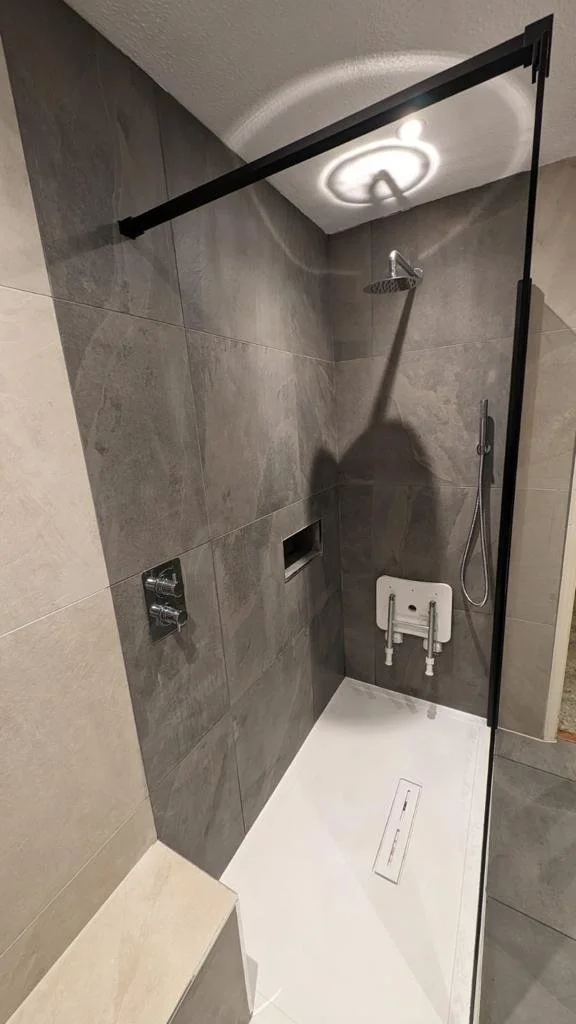Stylish adapted bathrooms
Recently we have had the pleasure of helping several local clients who have had changes to their mobility and need a little extra help and security when accessing their bathrooms. For many individuals with mobility challenges or disabilities, the bathroom can be one of the most inaccessible spaces in the home. However, with thoughtful design and modifications, it's possible to create a bathroom that is both functional and welcoming for people of all abilities. We have aimed to make bathing less of a challenging and daunting task and helped to restore the pleasure in a gorgeous hot shower or a lovely long soak in the bath. In this blog post, we'll explore the key considerations and tips for designing an adapted bathroom that prioritises accessibility, safety, and comfort.
Before undertaking work to modify the bathroom, there are a few key factors to consider:
1. Assessing needs: Before embarking on any modifications, it's essential to assess the specific needs of the individual who will be using the adapted bathroom. Consider factors such as mobility limitations, strength, balance, and any specific requirements for accessibility equipment or assistive devices.
2. Widening Doorways: One of the first steps in creating an accessible bathroom is ensuring that doorways are wide enough to accommodate wheelchairs or mobility aids. Standard doorways are typically around 30 inches wide, but for accessibility, a minimum width of 36 inches is recommended.
3. Installing Grab Bars: Grab bars are essential for providing support and stability in the bathroom, particularly around the toilet and shower or bathtub area. Install grab bars securely to the wall at appropriate heights to assist with sitting, standing, and maneuvering safely.
4. Choosing Accessible Fixtures: Opt for fixtures that are specifically designed for accessibility, such as walk-in showers with low or no thresholds, adjustable-height showerheads, and comfort or wall-mounted toilets with grab bars. In one instance we reduced the boxing around the existing vertical pipework creating a little bonus space by the shower where we installed a little seat to perch on just outside the shower and right by a nice warm towel rail.
5. Slip-Resistant flooring: Slippery floors can pose a significant safety hazard, especially in a bathroom environment. Choose flooring materials that are slip-resistant and easy to clean, such as textured tiles or non-slip vinyl flooring. Another tip is to place non-slip mats or rugs in key areas of the bathroom, such as in front of the sink, toilet, and shower or bathtub, to provide added traction and reduce the risk of slips and falls.
6. Lever-Style taps Traditional knob-style taps can be difficult for individuals with limited hand dexterity to operate. Consider installing lever-style taps, which are easier to grip and require minimal effort to turn on and off.
7. Adequate lighting: Good lighting is essential for safety and visibility in the bathroom, especially for individuals with vision impairments. Ensure that the bathroom is well-lit with bright, evenly distributed lighting, and consider installing motion-activated lights for added convenience.
8. Accessible Storage: Make sure that storage areas in the bathroom are easily accessible, with shelves, cabinets, and drawers located at heights that can be reached from a seated or standing position. Consider installing pull-out shelves or organizers for better accessibility and organization.
9. Flexibility: Often the bathroom is shared by users with different levels of mobility. It’s really easy now to fit shower seats and grab rails which fold away when not needed and make the bathroom feel much as it was prior to modification, that lovely welcoming space we can all enjoy.
Creating an adapted bathroom is not just about making physical modifications; it's about promoting independence, dignity, and inclusion for individuals of all abilities. By incorporating thoughtful design elements and accessibility features, you can transform your bathroom into a safe, comfortable, and welcoming space for everyone.




